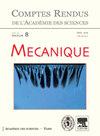Terra Bulla, the influence of Yves Couder on the emerging domain of arts and physics sciences
IF 1
4区 工程技术
Q4 MECHANICS
引用次数: 0
Abstract
At the beginning of the eighties Yves Couder started to work in pattern formation field trying to observe and understand structures in complex flows. His approach was different using humble experiments to materialise simple but powerful and elegant ideas. He was establishing with Pierre Gilles De Gennes and Étienne Guyon in particular a novel way of making scientific proof by using demystified “experiences de coin de table” where the simplicity of the setting made the demonstration even more powerful. Science was becoming performative and scientists were in public talks as well as in the lab engaged physically in a tactile way with their experiments. One of Yves first contributions was to use soap films to perform hydrodynamics experiments in two dimensions. The experiments with soap films brought a sense of fragility, emotion and poetry into science; they started and entirely new field of research on bidimensional turbulence using films. This research and novel approach to science opened a pathway for some current domains like table-top sciences, frugal sciences, new types of popularisation like “la main à la pate”, but also the rapidly developing field of arts & sciences. In the present article I will draw on the affiliation of Yves’ works with the arts and sciences using several examples from my own work which is greatly inspired by his approach but also from the work of the fantastic artist duo Evelina Domnitch and Dmitry Gelfand.Terra Bulla, Yves Couder对新兴艺术和物理科学领域的影响
20世纪80年代初,伊夫·库德开始在模式形成领域工作,试图观察和理解复杂流动中的结构。他的方法是不同的,用简单的实验来实现简单但强大而优雅的想法。他与Pierre Gilles De Gennes和Étienne Guyon一起建立了一种新颖的科学证明方式,通过使用去神秘化的“经验,硬币,桌子”,简单的设置使演示更加强大。科学变得越来越具有表演性,科学家们不仅在实验室里做实验,也在公开场合做演讲。伊夫最早的贡献之一是利用肥皂膜进行二维流体力学实验。肥皂片的实验给科学带来了脆弱、情感和诗意;他们开创了利用薄膜研究二维湍流的全新领域。这项研究和新颖的科学方法为一些当前的领域开辟了一条道路,如桌面科学,节俭科学,新型的普及,如“主流科学”,以及快速发展的艺术和科学领域。在这篇文章中,我将利用我自己的作品中的几个例子来借鉴伊夫的作品与艺术和科学的联系,我的作品深受他的方法的启发,也受到了出色的艺术家二人组Evelina Domnitch和Dmitry Gelfand的作品的启发。
本文章由计算机程序翻译,如有差异,请以英文原文为准。
求助全文
约1分钟内获得全文
求助全文
来源期刊

Comptes Rendus Mecanique
物理-力学
CiteScore
1.40
自引率
0.00%
发文量
0
审稿时长
12 months
期刊介绍:
The Comptes rendus - Mécanique cover all fields of the discipline: Logic, Combinatorics, Number Theory, Group Theory, Mathematical Analysis, (Partial) Differential Equations, Geometry, Topology, Dynamical systems, Mathematical Physics, Mathematical Problems in Mechanics, Signal Theory, Mathematical Economics, …
The journal publishes original and high-quality research articles. These can be in either in English or in French, with an abstract in both languages. An abridged version of the main text in the second language may also be included.
 求助内容:
求助内容: 应助结果提醒方式:
应助结果提醒方式:


